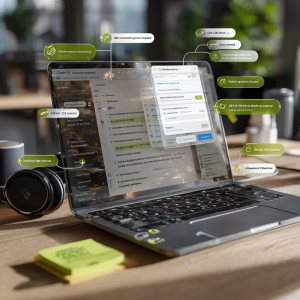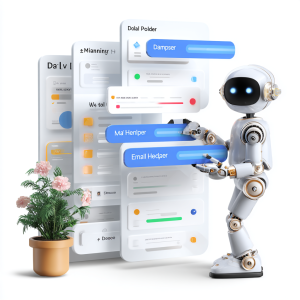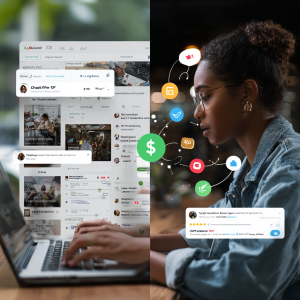
Day 01 – ChatGPT for Everyday AI Tasks
Level: Beginner
Total Length: 12+ Full Pages
Tag: #ChatGPT #Beginner #ProductivityAI #FreelancerTool
Challenge Theme: Learn, Apply, Monetize
🎓 Sir Magnus Albright (Professor – Older Joe voice)
“Today, you have taken your first decisive step into the world of applied artificial intelligence. What you have accomplished may appear simple on the surface — learning to prompt, navigating the interface, and creating your first micro-service — but these are the very foundations upon which mastery is built. Every great scholar begins with tools that feel modest yet prove transformative with practice. Remember: consistency, precision, and clarity in your instructions will always yield higher-quality results. Carry this momentum into tomorrow, and you will not merely use AI — you will command it as a true partner in your work.”
🧭 Kwame Dede (Life Coach – James NL voice)
“Well done for finishing Day 1. What matters most right now is not perfection but the fact that you showed up, experimented, and created something tangible. You’ve already proven that ChatGPT isn’t just theory — it can produce results for you. From here, I want you to reflect: how will you use today’s skills in your real life tomorrow? Write it down, no matter how small. This is how you build consistency, and consistency is what turns learning into power. Keep moving — Day 2 is waiting for you.”
Key Mastery Skills & Concepts Covered — Day 01
- Understanding ChatGPT core functions
- Free vs Pro (GPT-3.5 vs GPT-4) capabilities
- ChatGPT interface navigation
- Prompt box usage
- Sidebar threads management
- Regenerate response function
- Copy and share outputs
- Daily life use-cases across roles
- Prompt engineering basics
- Role prompts
- Formatting prompts
- Tone shaping prompts
- Reasoning prompts
- Prompt chaining method
- Debugging prompts (quick fixes)
- Monetization strategies with ChatGPT
- Selling AI templates
- Offering micro-services
- Launching newsletters or TikTok channels
- Creating and saving a productivity bot
- Daily reflection with AI assistant
What is ChatGPT?
ChatGPT is a conversational AI developed by OpenAI, designed to simulate human-like dialogue and provide intelligent, context-aware answers. At its core, ChatGPT is a language model trained on massive amounts of text that can generate, refine, and structure information in ways that feel natural.
Instead of being just a chatbot for casual Q&A, ChatGPT acts as a thinking partner, writing assistant, and productivity engine. You type in a request using plain language, and ChatGPT interprets it, generates structured responses, and often goes further by suggesting improvements or additional insights you may not have considered.
It’s available in two primary versions:
- Free Version (GPT-3.5): Fast, accessible to anyone with an OpenAI account, ideal for basic tasks such as summaries, brainstorms, and short content creation.
- Pro Version (GPT-4): Smarter and more nuanced, capable of deeper reasoning, more accurate answers, and advanced tasks. GPT-4 also includes memory features and access to tools (like browsing, code execution, and file analysis).
Key Idea: ChatGPT is not “just another chatbot.” It’s a multi-purpose engine that can help you ideate, write, plan, organize, and even automate work. Think of it as a personal assistant for your brain that never sleeps and costs far less than hiring staff.
Why It Matters for Beginners
Many people assume AI is complicated, reserved for programmers or data scientists. ChatGPT breaks that barrier:
- Plain Language Interface: You don’t need technical skills. You simply type requests as though you’re talking to a colleague.
- Productivity Multiplier: Tasks that used to take hours (emails, lesson plans, blog drafts, reports) can now be completed in minutes.
- Creative Partner: When facing a blank page or creative block, ChatGPT helps you brainstorm, outline, and polish ideas into actionable drafts.
- Low-Cost Startup Tool: You can begin an online business or freelance service today with no upfront investment — simply using ChatGPT to deliver value.
- Confidence Builder: For those starting their journey in AI, ChatGPT provides an instant way to practice, experiment, and generate results without fear of failure.
Beginner Insight: Mastering ChatGPT early gives you an edge. The faster you learn to communicate with it effectively, the sooner you can unlock income opportunities, boost your daily productivity, and gain confidence in navigating the larger AI landscape.
Today’s Learning Goals
By the end of Day 1 of the Challenge, you will:
- Understand ChatGPT’s Core Functions
Learn what it can and cannot do, and why it’s more than a question-answer bot. - Create Your First Structured Productivity Prompt
Instead of “write me an email,” you’ll design prompts that yield professional-quality results consistently. - Interact More Effectively
Learn how to “talk” to ChatGPT to get detailed, accurate, context-aware responses. - Apply ChatGPT to a Real Scenario
Walk through how a beginner freelancer can set up a first portfolio piece or client outreach. - Monetize a Simple Output
Produce a tangible asset (e.g., blog draft, LinkedIn post, email template) that you can sell or offer as a service.
TOOL OVERVIEW: INTERFACE + FEATURES
Core Interface Areas (Web App)
When you first log into ChatGPT via the web app, the layout is intentionally simple so anyone can begin immediately. Each part of the interface is designed to reduce friction and keep the focus on the conversation. Here are the main areas you’ll use every day:
- Prompt Box (bottom of the screen):
This is where you type your instructions, questions, or ideas. Think of it as the conversation starter. A well-structured prompt in this box is the difference between a vague, generic response and a professional, high-value answer that you can actually use. - Sidebar Threads (left-hand side):
Each conversation is saved as a “thread.” This feature allows you to return to previous chats, continue where you left off, or organize your sessions by topic (e.g., “Business Ideas,” “Freelance Emails,” “Lesson Outlines”). It’s like having separate folders for every project inside your AI workspace. - Regenerate Response Button (beneath each reply):
Didn’t like the answer? Click “Regenerate” and ChatGPT will try again with a different version based on the same prompt. This is especially useful when you want alternative drafts, need more variety, or want to compare different styles before choosing the best one. - Copy/Share Options:
You can copy answers directly into your notes, documents, or slides. You can also share the entire thread link with a client, teammate, or coach, making collaboration faster and smoother. This feature turns ChatGPT into a team-friendly tool instead of just a solo assistant.
Tip: The web interface is minimal by design. This simplicity means the real power lies not in clicking buttons, but in how you communicate through the Prompt Box. The better your instructions, the more professional and actionable your results will be.
Key Capabilities
ChatGPT’s abilities differ slightly between GPT-3.5 (Free) and GPT-4 (Pro). Here’s how they compare in everyday use:
| Feature | GPT-3.5 | GPT-4 |
|---|---|---|
| Summarizing text | ✅ Works well | ✅ More accurate and nuanced |
| Creative writing | ✅ Strong | ✅✅ Richer, more human-like ideas |
| Memory | ❌ Not available | ✅ Retains information across sessions (if enabled) |
| Plugins / Tools | ❌ None | ✅ Can use browsing, file reading, code interpreter, etc. |
| Code understanding | Basic support | Advanced debugging, explanations, and generation |
Takeaway:
- Beginners can do plenty with GPT-3.5 (summaries, ideas, drafts).
- GPT-4 is for those who want precision, long-term memory, and advanced tasks like coding, research, or plugin-powered workflows.
Setup Guide
Getting started with ChatGPT is quick it takes less than 5 minutes:
- Visit the Website
Go to chat.openai.com. - Sign Up
Create a free account using your email address, Google, Microsoft, or Apple ID. - Choose Your Plan
• Stay on the Free Plan (GPT-3.5) if you’re just experimenting.
• Upgrade to ChatGPT Plus ($20/month) if you want GPT-4 access, priority speed, and advanced features. - Start a New Thread
Click “+ New Chat” in the sidebar. This gives you a clean conversation window. - Type Your First Prompt
In the Prompt Box, try:
“Hi ChatGPT, can you explain what you can help me with today as a beginner in AI?”You’ll instantly receive a structured response — proof that ChatGPT is ready to assist you from day one.
Bottom Line: The interface is intentionally simple, but beneath the minimal design lies a powerful engine. With just a free account, you can summarize, brainstorm, and create. With GPT-4, you unlock memory, plugins, and advanced reasoning — essential for scaling to real-world projects and monetization.
USE-CASES FOR DAILY LIFE
Use-Case Examples by Role
One of ChatGPT’s biggest strengths is its flexibility. It doesn’t serve just one industry or profession, instead, it adapts to your role and needs. Here’s how different people use ChatGPT in their daily lives:
- Student
- Summarize long readings into clear bullet points before class.
- Generate practice questions and mock quizzes to study smarter.
- Draft essays or research outlines that reduce blank-page anxiety.
- Ask it to explain complex concepts in simple language, like a tutor.
- Freelancer
- Draft professional proposals that win projects on platforms like Upwork or Fiverr.
- Create polished gig descriptions that highlight your skills.
- Manage repetitive client communication by generating polite, structured replies.
- Brainstorm fresh service offerings based on market demand.
- Remote Worker
- Generate fast, professional email responses.
- Prepare daily or weekly status updates in polished language.
- Build presentation slides by first generating content outlines.
- Organize meeting notes into clear action items.
- Social Media Assistant
- Write captions that are engaging and aligned with brand tone.
- Generate post ideas across different platforms (TikTok, Instagram, LinkedIn, Twitter/X).
- Build monthly content calendars in minutes instead of hours.
- Create hashtag sets and call-to-action variations for each campaign.
- Entrepreneur
- Brainstorm product ideas and refine them into clear offerings.
- Generate business names, slogans, and branding angles.
- Draft investor pitch decks or sales presentations.
- Create website copy, email campaigns, and FAQs for new launches.
Takeaway: No matter your background, ChatGPT adapts to your role. Instead of a one-size-fits-all tool, it’s like having a specialized assistant that reshapes itself depending on your needs.
What Makes ChatGPT Different?
While many apps automate specific tasks, ChatGPT stands out because it is dynamic, adaptable, and personalizable. Here’s why it’s different from a regular writing app or chatbot:
- Learns from Context in Each Conversation
ChatGPT remembers what you typed earlier in the same thread. This means you don’t need to repeat yourself constantly. If you’re working on a project, it builds on your previous instructions, giving continuity and saving time. - Personality Shaping with Tone Modifiers
You can control the style and tone of ChatGPT’s output by giving simple instructions such as:
• “Write in a professional, formal tone.”
• “Make this casual and friendly.”
• “Add humor, like a stand-up comedian.”
This flexibility allows you to adapt the writing style to your specific audience or platform. - Teaches It Your Writing Style
You can paste a sample of your own writing and say:
“Mimic this tone going forward.”
From then on, ChatGPT will try to mirror your voice, making it a powerful tool for personal branding, maintaining consistency in client projects, or streamlining your team’s communication style.
Key Insight: Unlike a static template or generator, ChatGPT adapts to you. The more you use it, the more you’ll learn how to steer it toward outputs that sound like you. This is what makes it a game-changer for students, professionals, and entrepreneurs alike.
REAL-WORLD SCENARIO: FREELANCER MONDAY
Starting a freelance career can feel overwhelming especially on your very first day. With no clients, no website, and no clear plan, it’s easy to get stuck in indecision. This scenario shows how ChatGPT can act as your personal mentor, giving you structure and focus to take your very first steps into freelancing with confidence.
Scene Setup
Imagine it’s Monday morning. You’ve made the decision to start freelancing but you don’t have clients, a website, or even a clear direction yet. You’re staring at your laptop, wondering where to begin.
Instead of panicking, you open ChatGPT and type:
“Act as my freelance mentor. What are 5 essential tasks I must do today to launch?”
ChatGPT’s Suggested Tasks
- Choose a niche (e.g., writing, design, virtual assistance).
- Create a Fiverr or Upwork profile to start building visibility.
- Write a short gig description that explains what you offer.
- Draft a cold outreach email for potential clients or small businesses.
- Create 3 content ideas you can use to begin marketing yourself on social media.
Key Takeaway: With one prompt, you’ve gone from uncertainty to a clear, actionable plan. ChatGPT serves as both a guide and a productivity partner, helping you focus on the tasks that matter most on Day 1 of your freelancing journey.
ChatGPT’s First Response
ChatGPT immediately gives you a step-by-step starter roadmap to launch your freelancing journey:
- Choose a Niche
• Example niches: writing, design, virtual assistance, social media, or video editing.
• Pick one area that matches your skills and interests you don’t need to be an expert, just focused. - Create a Fiverr or Upwork Profile
• Set up a freelancer account.
• Upload a photo, add a bio, and describe your services. - Write a Short Gig Description
• This is your mini sales pitch.
• Example: “I help small businesses create polished blog posts and engaging social media captions using AI tools.” - Draft a Cold Email for Lead Outreach
• Contact small businesses, coaches, or startups who may need your service.
• Keep it short, professional, and value-focused. - Create 3 Content Ideas for Marketing
• Example: a LinkedIn post about “AI for Small Business”, an Instagram carousel on “3 ways ChatGPT saves you time”, and a short tweet about freelancing with AI.
Key Insight: Within just minutes, you now have an actionable Monday checklist a clear plan that transforms uncertainty into momentum.
Expanded Prompt for ChatGPT
You can go one step further and make your request more specific. Type:
“Please give me real examples of gig titles and a sample cold outreach email to land a job.”
This forces ChatGPT to stop being generic and provide you with ready-to-use material.
ChatGPT’s Response (Expanded Example)
Sample Gig Titles:
- “I will write engaging blog content for your brand”
- “I will manage your Instagram and create daily captions”
- “I will design AI-powered pitch decks for startups”
- “I will edit short-form videos for TikTok, Reels, and YouTube Shorts”
- “I will provide professional customer support with AI tools”
These are the exact types of gigs that succeed on Fiverr and Upwork because they’re specific, outcome-focused, and easy for clients to understand.
Sample Cold Outreach Email
Subject: Helping [Company Name] Save Time with AI
Hi [Client Name],
I came across your website and really admire your mission, especially the way you [mention something specific about their work].
I specialize in helping small businesses save time and grow online by using AI-powered tools like ChatGPT. For example, I can:
- Write blog posts and newsletters in half the time
- Create social media captions that align with your brand
- Handle repetitive writing tasks so you can focus on growth
Would you be open to exploring a small starter project this week? I’d love to support your content strategy and show you the value AI can bring.
Best regards,
[Your Name]
Why This Matters
Freelancing can feel overwhelming when you’re starting from zero no clients, no direction, and no roadmap. Instead of wasting weeks in uncertainty, ChatGPT acts as both a mentor and a productivity engine. It helps you clarify your first steps, create professional outputs, and build momentum immediately. This matters because the faster you move from ideas to action, the sooner you start building confidence, credibility, and income.
- You didn’t need to figure everything out from scratch.
- ChatGPT served as both a mentor and a tool, giving you exact wording and steps.
- By the end of Day 1, you’re not just “thinking about freelancing” — you actually have a gig profile, a service description, and your first outreach email ready.
Key Lesson: ChatGPT is more than a writing assistant, it’s a launchpad for careers. With the right prompts, you can shortcut weeks of uncertainty into one productive day.
BUILD YOUR PRODUCTIVITY BOT
Your Mission Today
One of the most powerful ways to use ChatGPT isn’t just asking it random questions it’s creating a personalized assistant that works with you every day. Think of it like hiring a productivity coach, except it’s free, available 24/7, and tailored to your exact needs.
Here’s your first setup task:
Copy and paste this exact prompt into ChatGPT:
“You are my daily productivity assistant. Every morning, ask me:
– What are your top 3 goals today?
– What is your biggest priority?
– What will you avoid today?
Then, suggest a schedule in bullet points. Keep it simple.”
Why This Works
- Daily Reflection: By answering these 3 questions, you’ll begin each day with clarity.
- Focus on Priorities: ChatGPT reminds you not just what to do, but what to avoid which is equally powerful.
- Simple Scheduling: Instead of overwhelming you with complex planners, ChatGPT will give you a light, actionable schedule.
- Consistency: By saving the thread, you build a daily ritual that makes productivity automatic.
Example Interaction
Here’s how it plays out in practice:
You open ChatGPT tomorrow morning.
ChatGPT:
- What are your top 3 goals today?
- What is your biggest priority?
- What will you avoid today?
You answer:
- My top 3 goals: finish client proposal, exercise, prepare slides for class.
- Biggest priority: completing the proposal.
- I will avoid: scrolling Instagram.
ChatGPT replies:
- 9:00 AM – Work on client proposal (2 hours, no distractions).
- 11:30 AM – Take a 30-minute break, short walk or stretch.
- 12:00 PM – Review and polish proposal.
- 2:00 PM – Lunch break.
- 3:00 PM – Prepare slides for tomorrow’s class (2 hours).
- 6:00 PM – Gym or home workout.
- 8:00 PM – Review progress, light reading.
Key Insight: Within seconds, you have a personalized plan for the day tailored to your goals and priorities.
Save & Reuse
- Save the Conversation: Bookmark or pin the chat in your sidebar so you can return to it tomorrow.
- Make It a Habit: Open this same thread each morning and let ChatGPT run you through the routine.
- Upgrade Over Time: As you get used to it, you can add custom rules like:
- “Include time for deep work.”
- “Suggest healthy meal breaks.”
- “Add evening reflection questions.”
Key Insight: You’ve just built your first AI-powered Productivity Bot. It’s not just about completing today’s task it’s about creating a repeatable system where ChatGPT becomes your accountability partner, day after day.
MONETIZATION STRATEGY
Monetize ChatGPT in 3 Beginner-Friendly Ways
Many learners stop at “using ChatGPT for productivity.” But if you’re here to build a new income stream, you need to go further turning skills into cash. Below are three practical, low-barrier monetization paths you can start this week.
1. Create & Sell AI Templates
Instead of offering services one-by-one, you can sell pre-made templates powered by ChatGPT. These are reusable digital products that people download and apply instantly.
Examples of Templates:
- Resume/CV templates with optimized bullet points.
- LinkedIn bio generators.
- Ad copywriting frameworks.
- Cold email templates for freelancers.
- Blog outline generators.
Where to Sell Them:
- Gumroad: perfect for simple digital downloads.
- Etsy: high demand for resumes, planners, and content templates.
- Notion Market: great for productivity templates powered by AI prompts.
Beginner Advantage: You only build the template once, but you can sell it hundreds of times. It’s a simple way to earn passive income while learning.
Offer ChatGPT-Powered Services
If you prefer direct client work, position yourself as someone who uses AI to deliver faster, cheaper, and smarter results.
Example Offer:
“AI-Powered Bio Rewrites – $10 per bio”
In just 10–15 minutes, you can rewrite client bios using ChatGPT and deliver polished results.
Other Service Ideas:
- Social media captions for small businesses.
- Quick blog drafts for startups.
- Proofreading and tone adjustments for students.
- Product descriptions for e-commerce sellers.
Where to Find Clients:
- Fiverr & Upwork: Easy to set up gigs and get small jobs quickly.
- LinkedIn: Offer micro-services as part of your professional profile.
- Facebook Groups: Many entrepreneurs ask for affordable help.
Beginner Advantage: You don’t need advanced skills or complex setups just ChatGPT and the willingness to serve.
Start an AI Newsletter or TikTok Channel
If you enjoy sharing knowledge, you can monetize by building an audience around ChatGPT tips.
Content Ideas:
- “ChatGPT Prompt of the Day.”
- “5 ways AI saves time at work.”
- “Behind the scenes of freelancing with AI.”
Platforms to Use:
- Newsletter (Substack, Beehiiv): Grow email subscribers, then monetize with sponsorships or premium tiers.
- TikTok/Instagram Reels: Short “tips and tricks” content goes viral quickly.
- YouTube Shorts: Repurpose TikToks for more reach.
Monetization Options:
- Include affiliate links for AI tools, courses, or templates.
- Sell your own digital products once your audience grows.
- Offer premium content or consulting to loyal followers.
Beginner Advantage: You start by learning in public. Each tip you share not only helps others but also builds your credibility as an AI-savvy professional.
Prompt Template for Monetization
Sometimes the hardest part of monetizing is knowing where to start. Instead of guessing or overthinking, you can let ChatGPT act as your personal business coach by asking it to generate tailored money-making ideas. A single well-structured prompt can unlock dozens of practical paths you might not have considered.
Try this prompt:
“Act as a business coach. Suggest 5 ways I can earn money using ChatGPT as a beginner with no capital and just 3 hours a day.”
This will give you fresh, low-cost ideas tailored to your available time and resources.
Key Insight: Monetization is not about knowing everything. It’s about taking action quickly with the resources you have. ChatGPT lowers the barrier so anyone with zero capital can start freelancing, selling templates, or building an audience today.
ADVANCED PROMPT STRATEGY
Prompt Engineering 101
Why this matters: Great prompts = great outputs. Treat every prompt like a mini-brief: tell ChatGPT who to be, what to do, with what info, how to format it, how it should sound, and what “good” looks like. Use the patterns below as copy-paste frameworks.
1. PROMPT ROLES — “WHO” IS SPEAKING
What it does:
Setting a role loads domain expectations (jargon, structure, depth). It narrows the model’s “voice” and improves relevance.
How to use:
- “Act as a copywriter for DTC skincare.”
- “Pretend you’re my resume coach for tech roles.”
- “You are a senior React developer.”
- “Act as an IELTS speaking examiner.”
- “Be a small-business legal explainer (non-legal advice).”
Good role prompt pattern:
“Act as a [specific role] for [audience/context]. You prioritize [goals]. Avoid [off-limits].”
Examples:
- “Act as a copywriter for a wellness brand targeting busy moms. You prioritize clarity and benefits over features. Avoid medical claims.”
- “You’re my resume coach for entry-level data analyst roles. You tailor bullets to impact + metrics. Avoid vague verbs.”
Quick A/B (see the effect):
A) “Write about our product.”
B) “Act as a DTC copywriter for eco-home goods. Write 3 benefit-led headlines and 3 CTA options for an Instagram carousel.”
FORMATTING INSTRUCTIONS — “HOW” TO DELIVER
What it does:
Formatting instructions force structure (tables, bullets, JSON) so outputs paste cleanly into docs, Notion, websites, or automations. This ensures consistency and saves editing time.
How to use:
- “Give answers in a table format with columns: ‘Audience’, ‘Problem’, ‘Hook’.”
- “Use short bullet points only; max 12 words per bullet.”
- “Return valid JSON with this schema: {‘title’: string, ‘bullets’: string[]}”
- “Provide a numbered list, then a 1-paragraph summary.”
Copy-paste snippets:
- Table:
“Present as a table with columns: ‘Idea’, ‘What it is’, ‘Effort (Low/Med/High)’, ‘Expected Outcome’.” - Bullets:
“Use 5–7 bullets. Each bullet ≤ 15 words. No fluff.” - JSON (for automations):
“Return valid JSON only. Schema:
{
‘title’: string,
‘target_audience’: string,
‘outline’: string[],
‘cta’: string
}
If any field is unknown, use an empty string.” - Comparison grid:
“Create a comparison table. Columns: ‘Option’, ‘Pros’, ‘Cons’, ‘Best For’, ‘Example Use Case’.”
Formatting + quality bar (together):
“Output: 7 bullets, each ≤ 15 words, actionable verbs first, no duplications, no buzzwords.”
TONE SHAPING — “SOUND LIKE THIS”
What it does:
Tone shaping controls voice to match the brand or audience without requiring extra rewriting later. By setting the tone upfront, you ensure consistency across all outputs.
How to use:
- “Make it sound friendly but persuasive.”
- “Use a formal business tone.”
- “Write as a calm mentor; zero hype.”
- “Energetic, social-first copy; punchy sentences.”
Tone switch template:
“Rewrite the paragraph in 3 tones:
1. Friendly, helpful
2. Formal, executive
3. Playful, social media
Keep the same meaning; vary diction and rhythm.”
Mini examples (same message, 3 tones):
- Friendly: “Let’s simplify your resume so hiring managers see your best work fast.”
- Formal: “We will optimize your résumé to highlight quantifiable achievements for recruiter scan.”
- Playful: “Your résumé’s getting a glow-up—stats up front, fluff out back.”
Guardrails for tone:
“Avoid clichés, exclamation marks, and overpromising. Prefer concrete verbs over adjectives.”
REASONING MODE — “SHOW YOUR THINKING AS STRUCTURE”
(Use structured, visible steps, not hidden inner monologue.)
Goal:
Get clear, auditable steps (plans, assumptions, criteria) without requesting private chain-of-thought. Ask for outlines, checklists, or brief rationales that you can verify and reuse.
How to use:
- “Think step-by-step: first list assumptions, then a 5-step plan, then the final answer.”
- “Before answering, list the missing info and ask 3 clarifying questions.”
- “Propose 3 options with trade-offs, then recommend 1 and explain why in 3 bullets.”
- “Draft: Plan → Draft → Review → Final. Show each section clearly.”
Structured reasoning template:
“Task: [goal].
1. Assumptions (bullets)
2. Risks/unknowns (bullets)
3. 5-step plan (numbered)
4. Final deliverable (formatted per instructions)
If info is missing, ask targeted questions first.”
Quality rubric add-on:
“Include a 4-point self-check rubric at the end: Relevance, Clarity, Actionability, Brevity. If any score < 4/5, revise once.”
Clarifying-questions first:
“If required inputs are missing, ask up to 3 concise questions before drafting. If not missing, proceed.”
Hallucination guardrail:
“If a fact is uncertain, say ‘Not enough data’ and suggest how to verify.”
PUTTING IT TOGETHER — MASTER PROMPT TEMPLATES
A) Role + Task + Audience + Format + Tone + Quality Bar
“Act as a [role] for [audience]. Task: [what]. Constraints: [limits, compliance]. Format: [table/bullets/JSON—specify]. Tone: [tone]. Success criteria: [3–5 bullets]. If info is missing, ask up to 3 questions first.”
Example:
“Act as a resume coach for junior data analysts.
Task: Rewrite 4 bullets with metrics.
Format: 4 bullets, ≤ 18 words each, start with strong verb, include numbers.
Tone: confident, non-salesy.
Success: ATS-friendly keywords, quantifiable impact, no vague verbs.
If info missing, ask up to 2 questions first.”
B) Plan → Draft → Review → Final
“Provide:
1. Plan (5 steps)
2. Draft (bullets or brief text)
3. Review (what to improve; 3 bullets)
4. Final (clean, ready to paste)
Use concise language.”
C) Options → Trade-offs → Recommendation
“Give 3 options with pros/cons and ‘Best For’. Then recommend 1 with a 3-bullet rationale. Format as a table + short summary.”
D) Anti-fluff Mode
“Be concrete. Replace adjectives with data/examples. Each bullet ≤ 14 words. No clichés.”
DEBUGGING YOUR PROMPTS — QUICK FIXES
- Symptom: Vague, generic answer
Fix: Add role, audience, success criteria, and a format. Limit length. - Symptom: Too long, verbose
Fix: Set bullet limits and word caps. “≤ 120 words” or “7 bullets max.” - Symptom: Off-tone
Fix: Provide a 3-tone sample and pick your favorite; ask it to rewrite in that tone. - Symptom: Missing info invented
Fix: Add guardrail: “If unknown, say ‘Not enough data’ and list how to find it.” - Symptom: Hard to paste into tools
Fix: Force JSON/table with exact schema/columns.
READY-TO-USE EXAMPLES (COPY/PASTE)
- Copywriter brief (carousel):
“Act as a DTC copywriter. Create 7 Instagram carousel slides for eco-cleaners. Format: 7 bullets, ≤ 12 words each, headline-style. Tone: friendly, persuasive. No claims; focus on benefits and routines.” - Resume coach rewrite:
“Act as a resume coach for junior data analysts. Rewrite these 3 bullets to include metrics and ATS keywords. Format: 3 bullets, ≤ 18 words each, start with a verb. If info is missing, ask 2 questions first.” - Outreach email (A/B):
“Act as a cold-email copywriter for B2B SaaS. Write 2 versions of a 90-word email. Tone: calm, value-first. Format: Subject, Body, CTA. Include 1 benefit and 1 proof point.” - Planning with structured reasoning:
“Task: Plan a 2-week content calendar for a fitness coach on TikTok.
1. Assumptions
2. Risks
3. 5-step plan
4. Final calendar (table: Date | Hook | Caption Idea | CTA)
If platform specifics are unknown, ask 2 questions first.” - JSON output for automation:
“Return valid JSON only. Schema:
{
‘post_ideas’: [{‘hook’: string, ‘caption’: string, ‘cta’: string}],
‘schedule’: [{‘date’: string, ‘platform’: string}]
}
If unknown, use empty strings.”
QUALITY BAR CHECKLIST (ADD TO ANY PROMPT)
“Before finalizing, ensure:
• Relevance: directly answers the task and audience.
• Clarity: simple sentences, plain words.
• Actionability: specific steps or examples.
• Brevity: no filler; respect word caps.
• Format: exactly as requested (table/JSON/bullets).
If any item fails, revise once and submit the improved version only.”
MICRO-PROMPTS FOR FAST ITERATION
- “Give me 3 tighter alternatives, same format.”
- “Make the verbs stronger; keep length caps.”
- “Compress by 30% without losing meaning.”
- “Swap to a formal business tone.”
- “List 3 assumptions you used; confirm they’re correct.”
- “If facts are uncertain, flag them and suggest a source to verify.”
SAFETY & SCOPE GUARDRAILS (RECOMMENDED)
Add one line to reduce risk and keep answers grounded:
- “Do not fabricate sources or stats; if unsure, say ‘Not enough data.’”
- “Ask up to 3 clarifying questions if requirements are ambiguous.”
- “Stay within ethical and legal boundaries; no sensitive personal data.”
Bottom line:
A strong prompt = Role + Task + Context + Constraints + Format + Tone + Quality bar + (Optional) Plan/Options. Use these templates to turn vague requests into crisp, monetizable outputs you can paste into documents, Notion, Fiverr, or client email — without extra editing.
ADVANCED PROMPT STRATEGY
Build a Prompt Chain
One of the most powerful ways to level up with ChatGPT is chaining prompts. Instead of giving one vague instruction, you create a sequence where the AI produces connected outputs step by step. This forces ChatGPT to think in stages and deliver results that build on each other.
Here’s a simple example you can copy-paste:
“You are an experienced brand strategist.
Step 1: Suggest 3 brand names for an AI-powered clothing brand.
Step 2: Pick the best one and write a slogan.
Step 3: Create a 1-paragraph brand story.”
With just one command, you don’t get a single answer you get a mini project output: three name options, a polished slogan, and a backstory you could paste directly into a pitch deck or website.
Why it works:
- Step 1 = Brainstorm options.
- Step 2 = Select the strongest idea.
- Step 3 = Expand into narrative form.
This “prompt chain” method saves hours because you bundle research + creative + polishing into one streamlined flow.
Case Study: Prompt Chaining in Action
Prompt chaining isn’t just a productivity hack it’s a direct path to monetization. By structuring prompts to deliver outputs you can sell, creative professionals transform ChatGPT from a simple tool into a business engine. The example below shows how one user turned a single prompt into a repeatable online income stream.
- User: Creative professional
- Use-Case: Sells Instagram bio rewrites online
- Tool: ChatGPT
Prompt Used:
“Rewrite this Instagram bio for a female fitness brand. Make it playful but bold. Add an emoji.”
Result:
- Launched a micro-service offering AI-powered bio rewrites.
- Priced at $10 per bio — quick, easy, repeatable.
- Sold 45+ bios in the first 3 weeks.
- Later bundled into packages of 5 bios for $25, increasing order value and earnings.
Lesson: With the right chained prompt, you don’t just create text you create a service you can sell repeatedly. This is the bridge from “playing with ChatGPT” to “building income with ChatGPT.”
MAKE YOUR FIRST AI SERVICE OFFER
Today’s Stretch Task
Today you’ll take your first real step toward monetization. Instead of just practicing prompts, you’ll create an actual service you could put online for $5–10. The goal isn’t to make a fortune right away it’s to build confidence, learn how to package a skill, and realize how quickly ChatGPT can turn into income.
Your mission: Create a one-page flier or simple digital offer.
- Use Canva to design a clean, professional one-pager, OR
- Use Notion to build a simple public page you can share as a link.
This page will explain your service, price, and how clients can get in touch.
Example Microservices You Can Offer
- Instagram Bio Rewrite
Quick, catchy bios with personality.
Example gig: “I will rewrite your Instagram bio in 3 bold, engaging styles — $10.” - 3 Tweet Ideas
Fast social content for busy founders.
Example gig: “I will create 3 scroll-stopping tweets tailored to your niche — $5.” - Blog Post Rewrite
Take existing blogs and polish them for flow, clarity, and SEO.
Example gig: “I will rewrite your blog for readability and impact — $10.” - Short Email Template
Sales, outreach, or customer support emails.
Example gig: “I will write a professional email template you can reuse — $10.”
Why this matters: These are low-ticket, fast-turnaround gigs that clients love because they solve small but nagging problems instantly. With just a few of these services, you’ll gain experience, confidence, and your first real AI-powered income.
Your Prompt to Build the Offer
Copy and paste this into ChatGPT to generate your first gig description:
“Act as a service creator. Help me write a 3-sentence gig description for a microservice I can sell for $10 using ChatGPT.”
Within seconds, you’ll get a short, polished description you can paste directly into your Canva flier or Notion page.
Save Your Output
- Keep the gig description handy — you’ll reuse it on Day 5 when we expand your microservice into a repeatable income stream.
- Save the Canva or Notion link in your notes so you can share it quickly if someone asks what you do.
Key Lesson: By the end of today, you’ll have your first sellable AI-powered service in writing. Even if you don’t launch it immediately, you’ve already crossed the line from “learning AI” to earning with AI.
DAILY RECAP + REFLECTION
What You Learned Today
Today wasn’t just an introduction it was your first full immersion into using ChatGPT as a real tool for productivity and income. Here’s a recap of what you’ve covered:
- Core Features and Interface
You explored the ChatGPT web app layout: the prompt box, sidebar, regenerate button, and copy/share features. You now understand how simple the interface is and how powerful it becomes once you master prompts. - Daily Life Use-Cases
From students to freelancers, entrepreneurs to social media assistants, you saw how ChatGPT adapts to different roles. The key takeaway: it’s not limited to one industry; it can flex to whatever you need. - Prompt Writing Best Practices
You learned that prompts are more than casual instructions. By setting roles, formatting, tone, and reasoning steps, you can shape ChatGPT’s responses into professional-grade outputs. - Real Monetization Paths
You now know 3 beginner-friendly ways to start earning with ChatGPT:
1. Selling AI templates.
2. Offering micro-services like bios or captions.
3. Sharing content via newsletters or TikTok with affiliate income. - Your First AI Assistant
You didn’t just learn you built something: a daily productivity bot. This assistant can guide you every morning with clarity and focus, proving ChatGPT can be a personal coach, not just a Q&A tool.
Reflection
Take 5–10 minutes to think through and write down your answers:
- Did you complete the DIY task?
• If yes, describe what you created (a Canva flier, a Notion page, a gig description).
• If no, ask yourself what blocked you and how you’ll tackle it tomorrow. - What service would you try offering with ChatGPT?
• Is it a quick microservice like Instagram bios or email templates?
• Or a creative service like blog rewrites or social media captions? - How did it feel to co-create with an AI?
• Were you surprised by the speed?
• Did it feel like collaboration or just automation?
• What possibilities does this open in your mind for the next 29 days?
Closing Thought:
Day 1 wasn’t about theory it was about action. You now have your first AI-powered assistant and your first sellable service idea. This momentum is the foundation of the 30-day challenge. Tomorrow, you’ll stack on top of this by learning another tool and multiplying your opportunities.
🧠 Mood Tracker
😃 Empowered | 🤯 Inspired | 😕 Confused | 🧊 Need Help
✅ Next Step
Continue to Day 02: Canva for Creators [Beginner]









